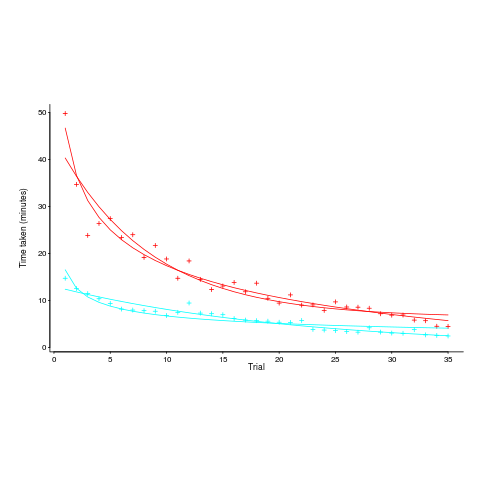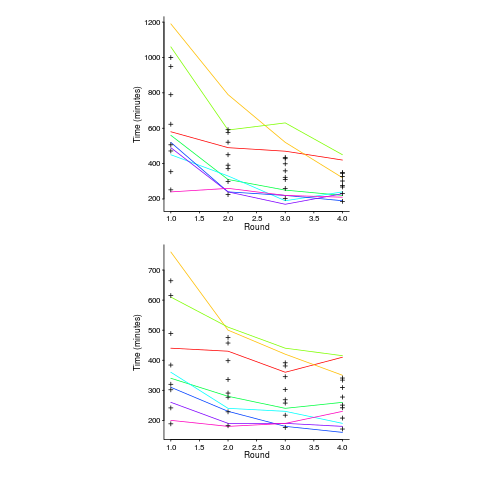Archive
Power law of practice in software implementation
People get better with practice. The power law of practice specifies  , where:
, where:  is the response time,
is the response time,  the amount of practice and
the amount of practice and  ,
,  and
and  are constants. However, sometimes an exponential equation is a better fit for to the data:
are constants. However, sometimes an exponential equation is a better fit for to the data:  . There are theoretical reasons for liking a power law (e.g., it can be derived from the chunking of information), but it is difficult to argue with the exponential fitting so much data better than a power law.
. There are theoretical reasons for liking a power law (e.g., it can be derived from the chunking of information), but it is difficult to argue with the exponential fitting so much data better than a power law.
The plot below, from a study by Alteneder, shows the time taken to solve the same jig-saw puzzle, for 35 trials (red); followed by a two week pause and another 35 trials (in blue; if anybody else wants to try this, a dedicated weekend should be long enough to complete over 20 trials). The lines are fitted power law and exponential equations (code+data). Can you tell which is which?

To find out if the same behavior occurs with software we need data on developers implementing the identical applications multiple times. I know of two experiments where the same application has been implemented multiple times by the same people, and where the data is available. Please let me know if you know of any others.
Zislis timed himself implementing 12 algorithms from the CACM collection in each of three languages, iterating four times (my copy came from the Purdue library, which as I write this is not listing the report). The large number of different programs implemented, coupled with the use of multiple languages, makes it difficult to separate out learning effects.
Lui and Chan ran an experiment where 24 developers (8 pairs {pair programming} and 8 singles) implemented the same application four times. The plot below shows the time taken to complete each implementation (singles top, pairs bottom, with black cross showing predictions made by a power law fit).

Different subjects start the experiment with different amounts of ability and past experience. Before starting, subjects took a multiple choice test of their knowledge. If we take the results of this test as a proxy for the ability/knowledge at the start of the experiment, then the power law equation becomes (a similar modification can be made to the exponential equation):

That is, the test score is treated as equivalent to performing some number of rounds of implementation). A power law is a better fit than exponential to this data (code+data); the fit captures the general shape, but misses lots of what look like important details.
The experiment was run over successive weekends. So there was opportunity for some forgetting to occur during the week days, and the amount forgotten will vary between people. It is easy to think of other issues that could have influenced subject performance.
This experiment must rank as one of the most interesting software engineering experiments performed to date.
Recent Comments